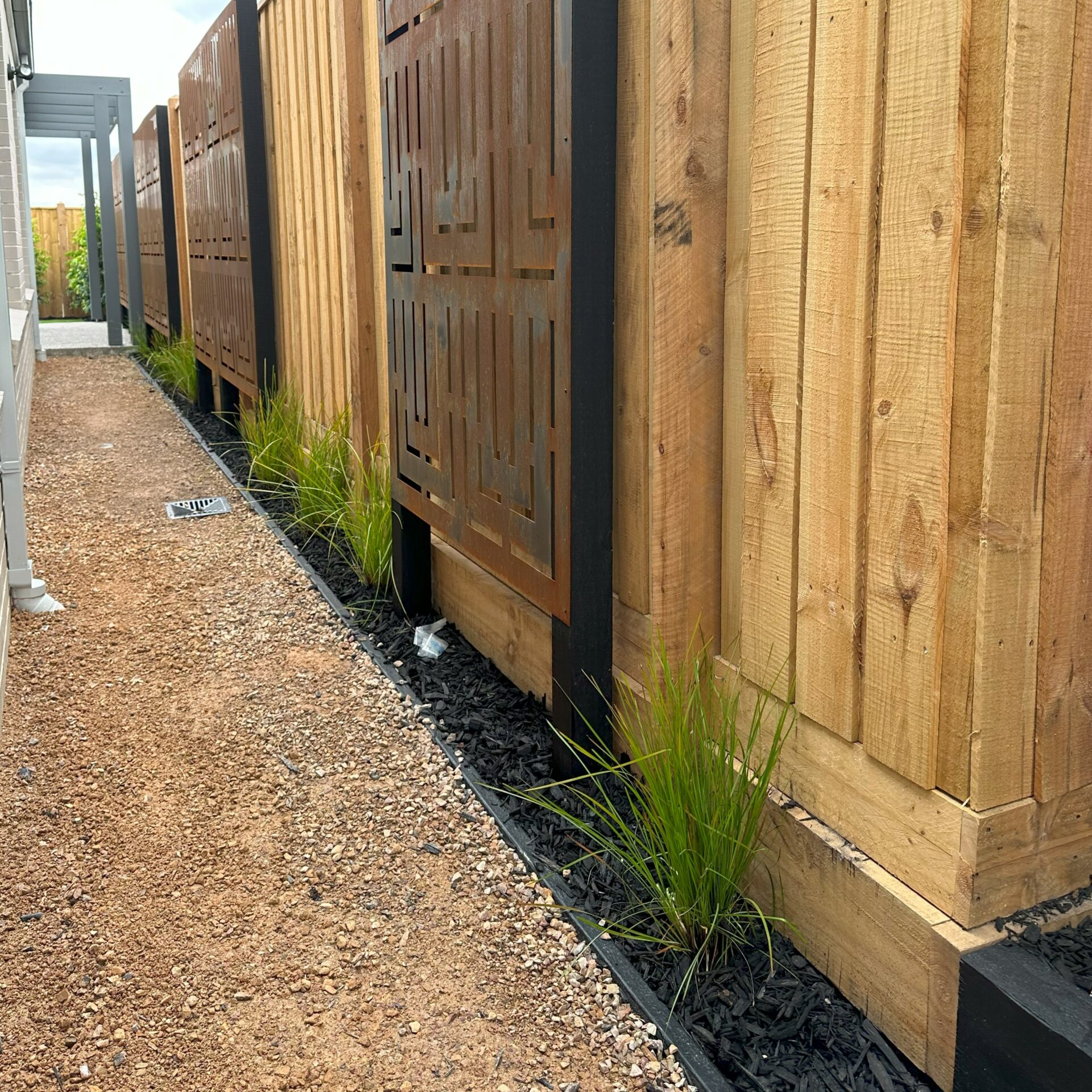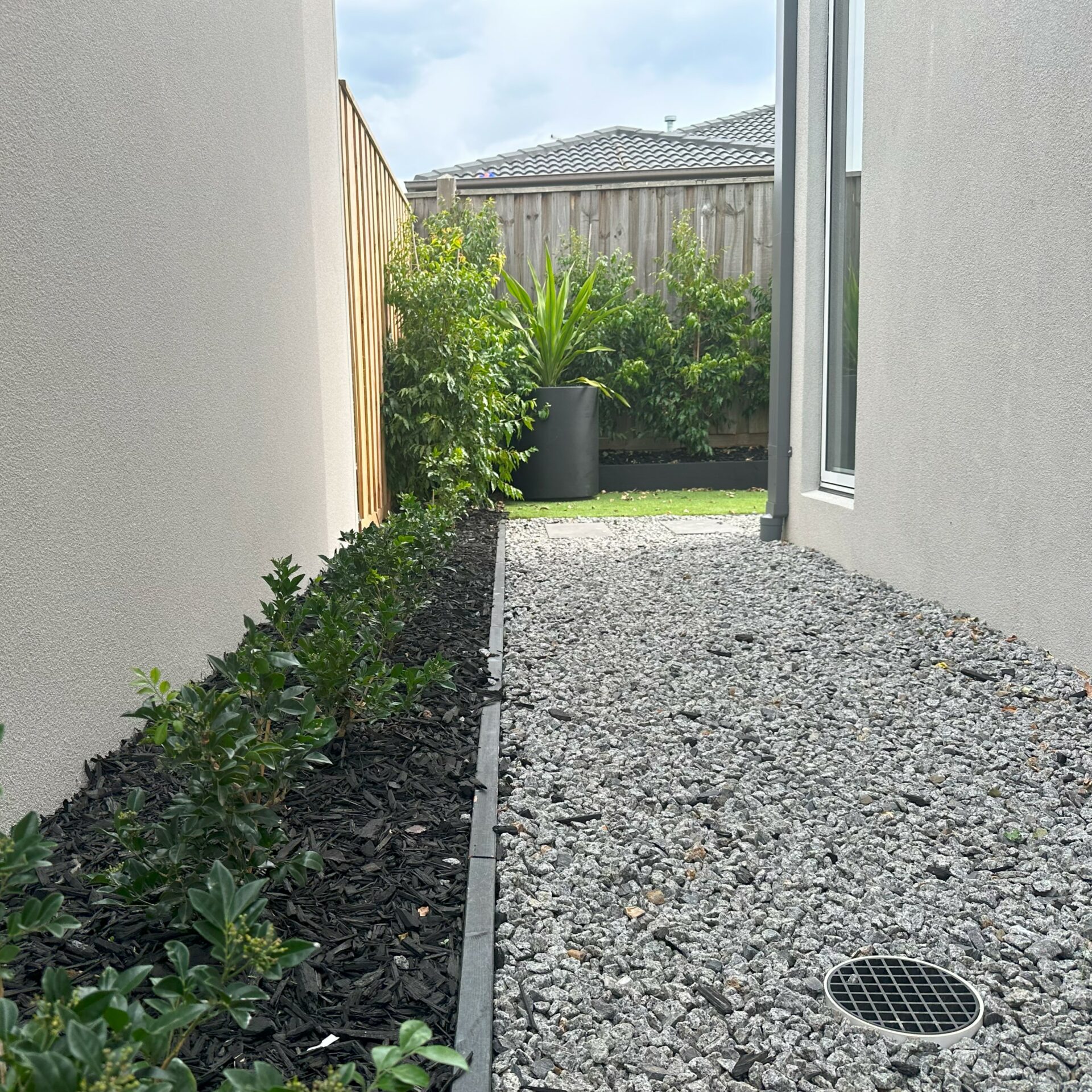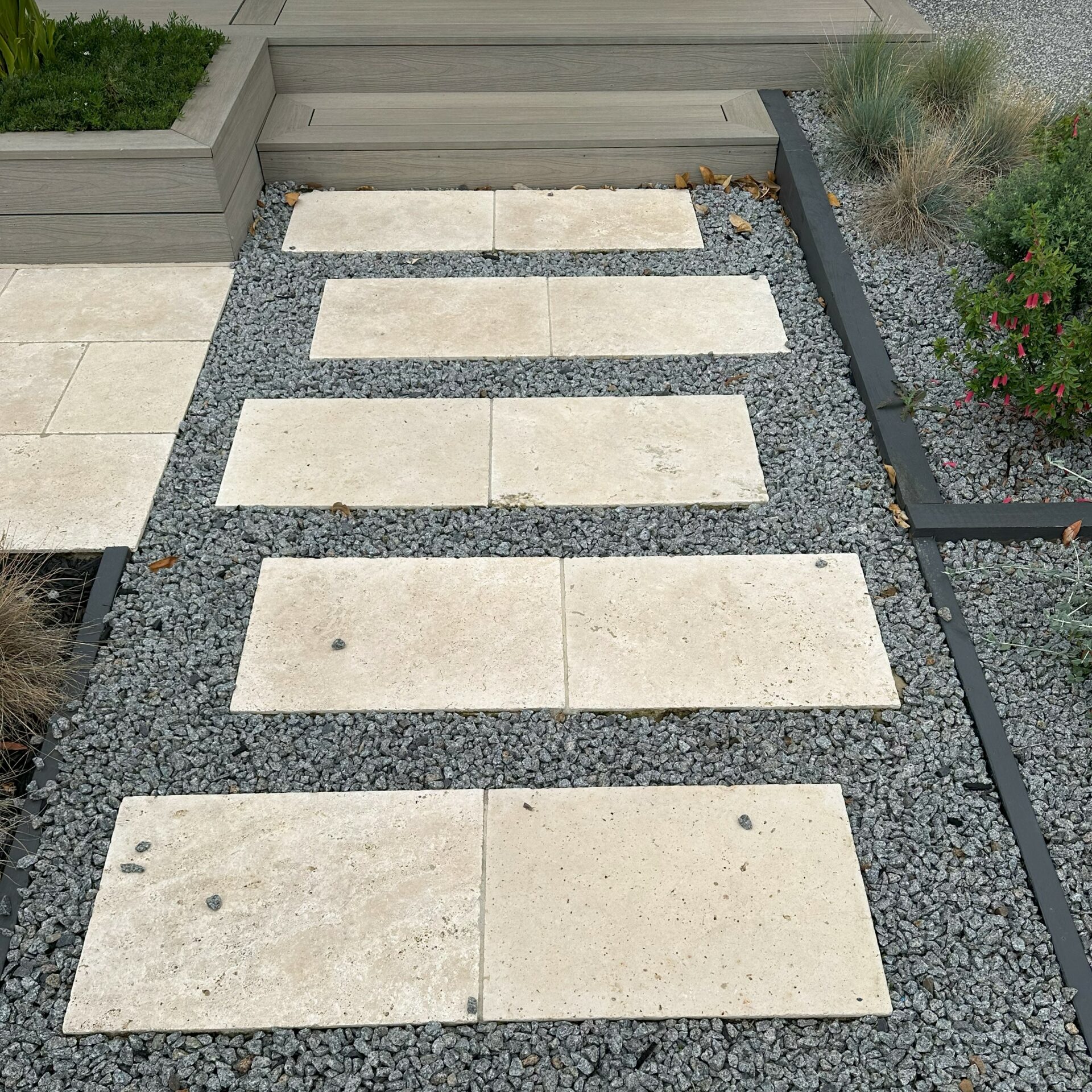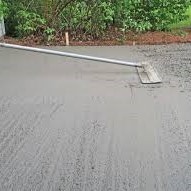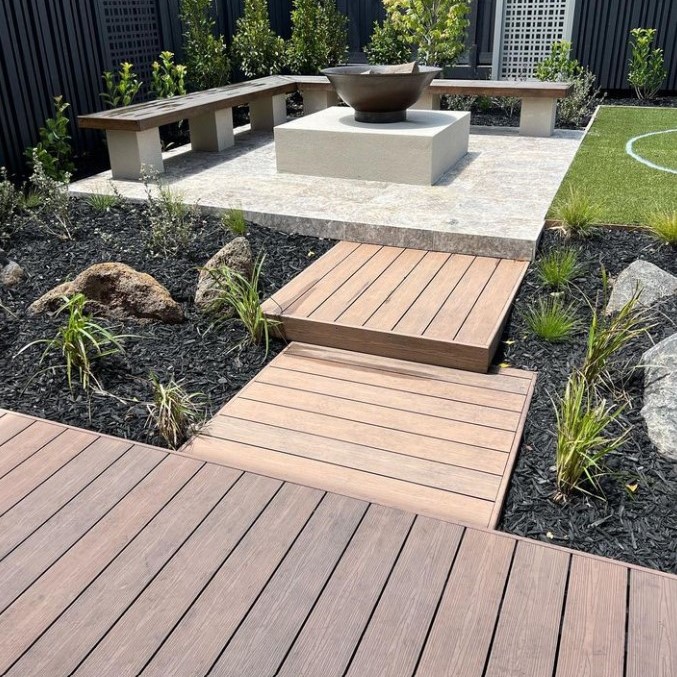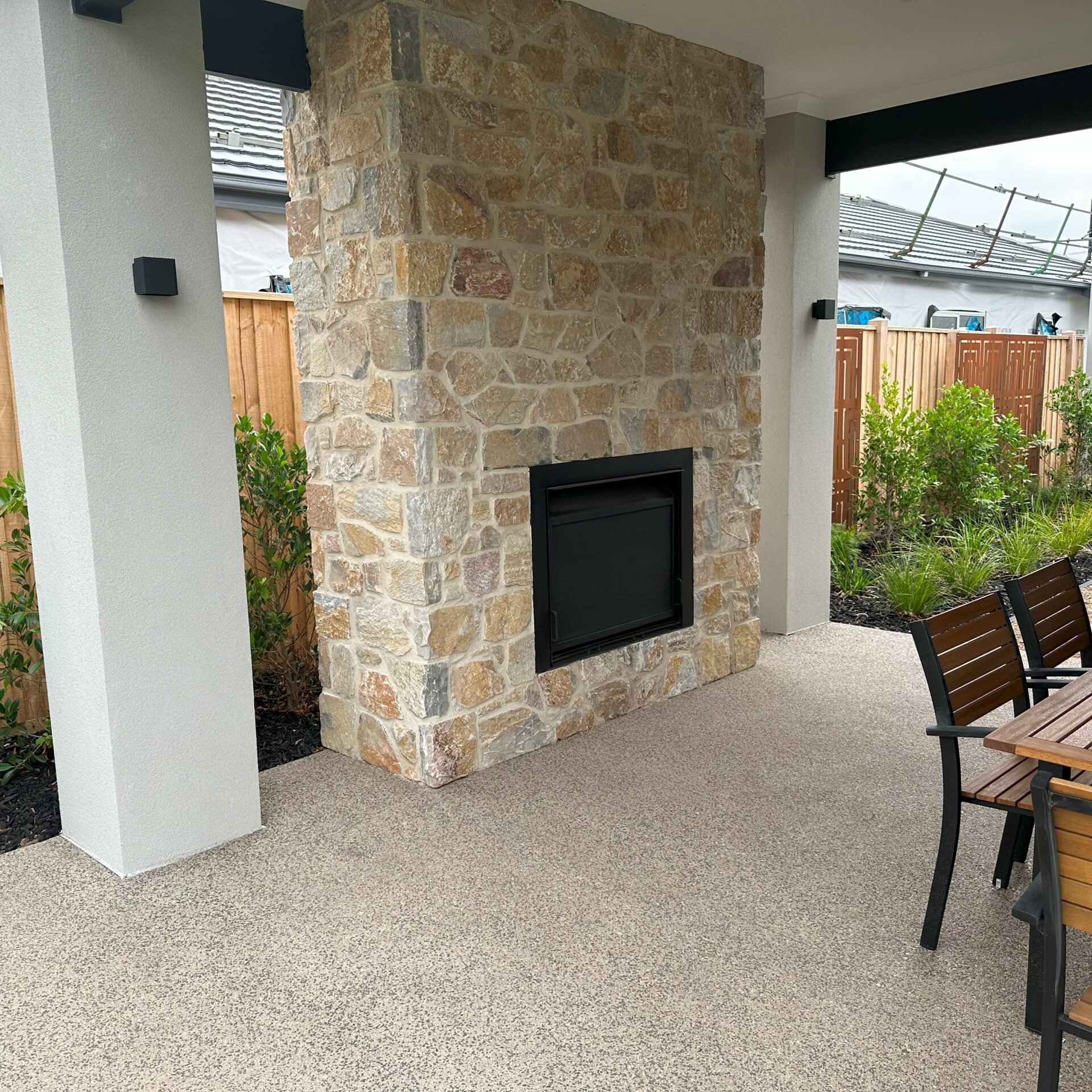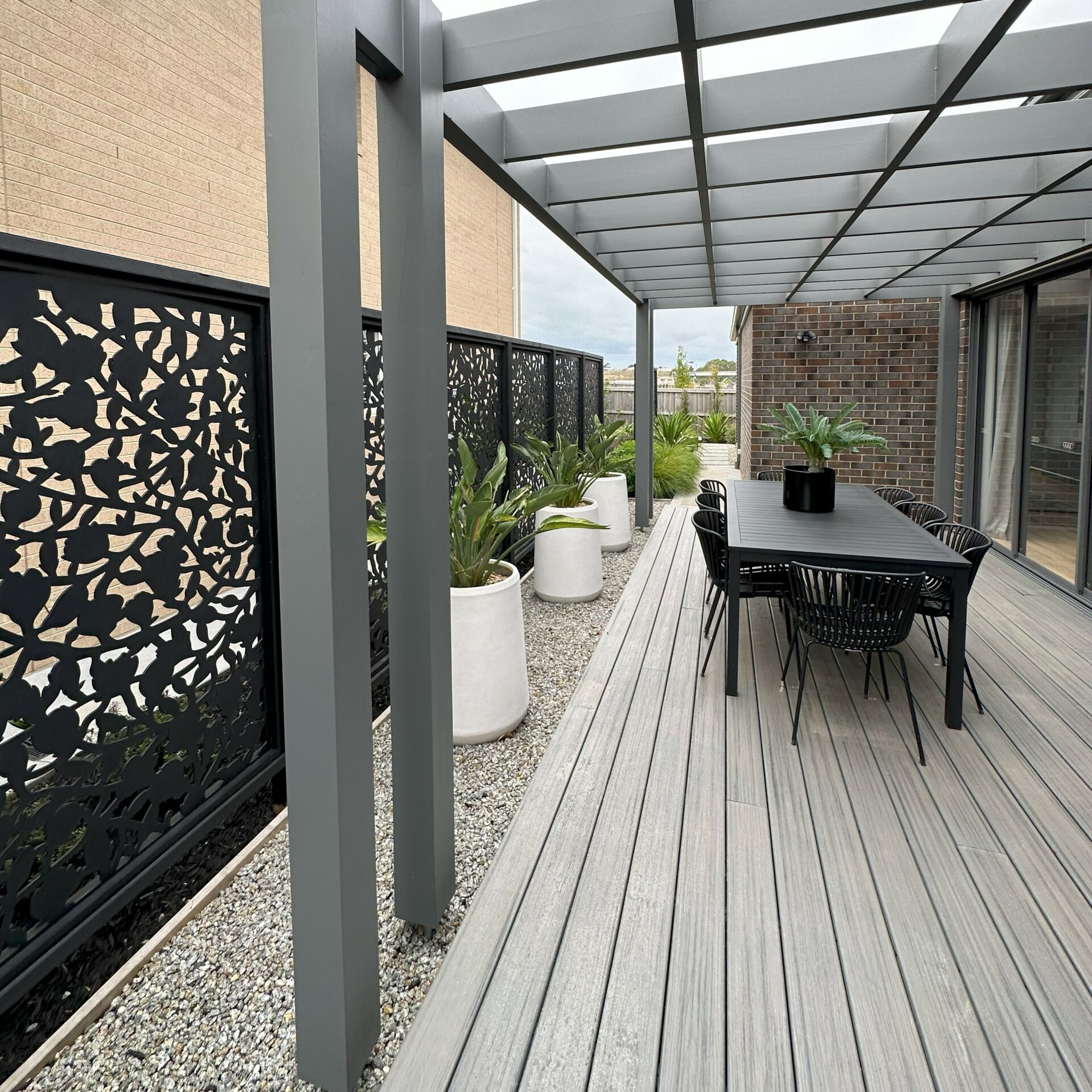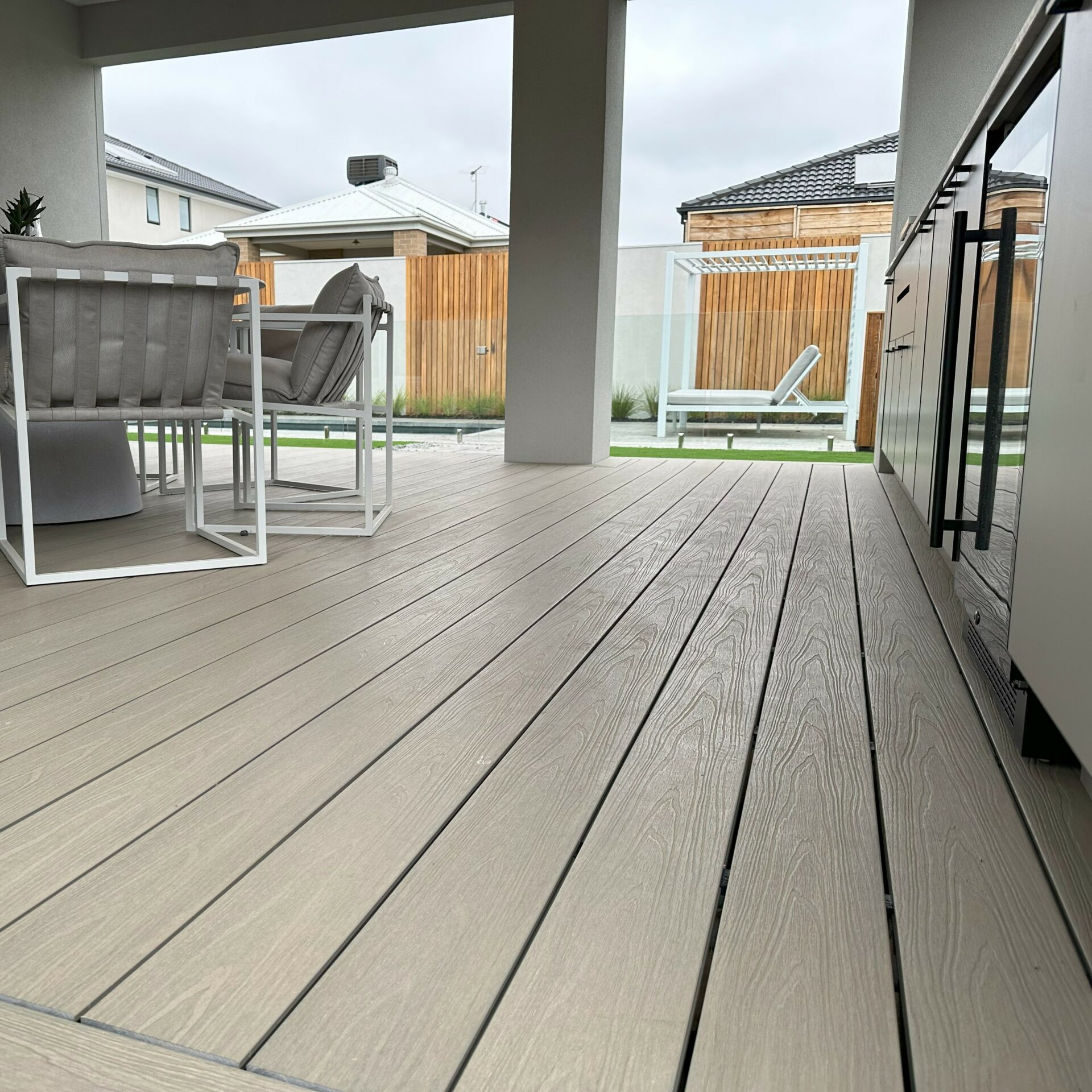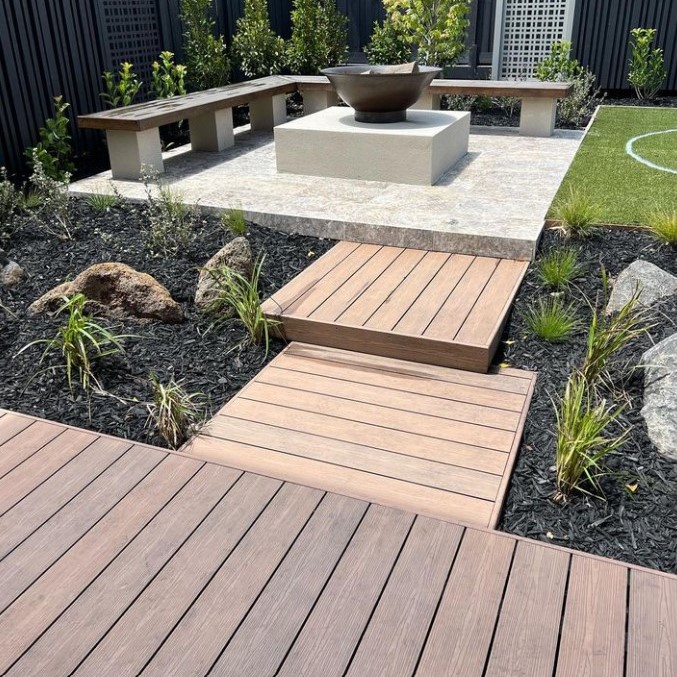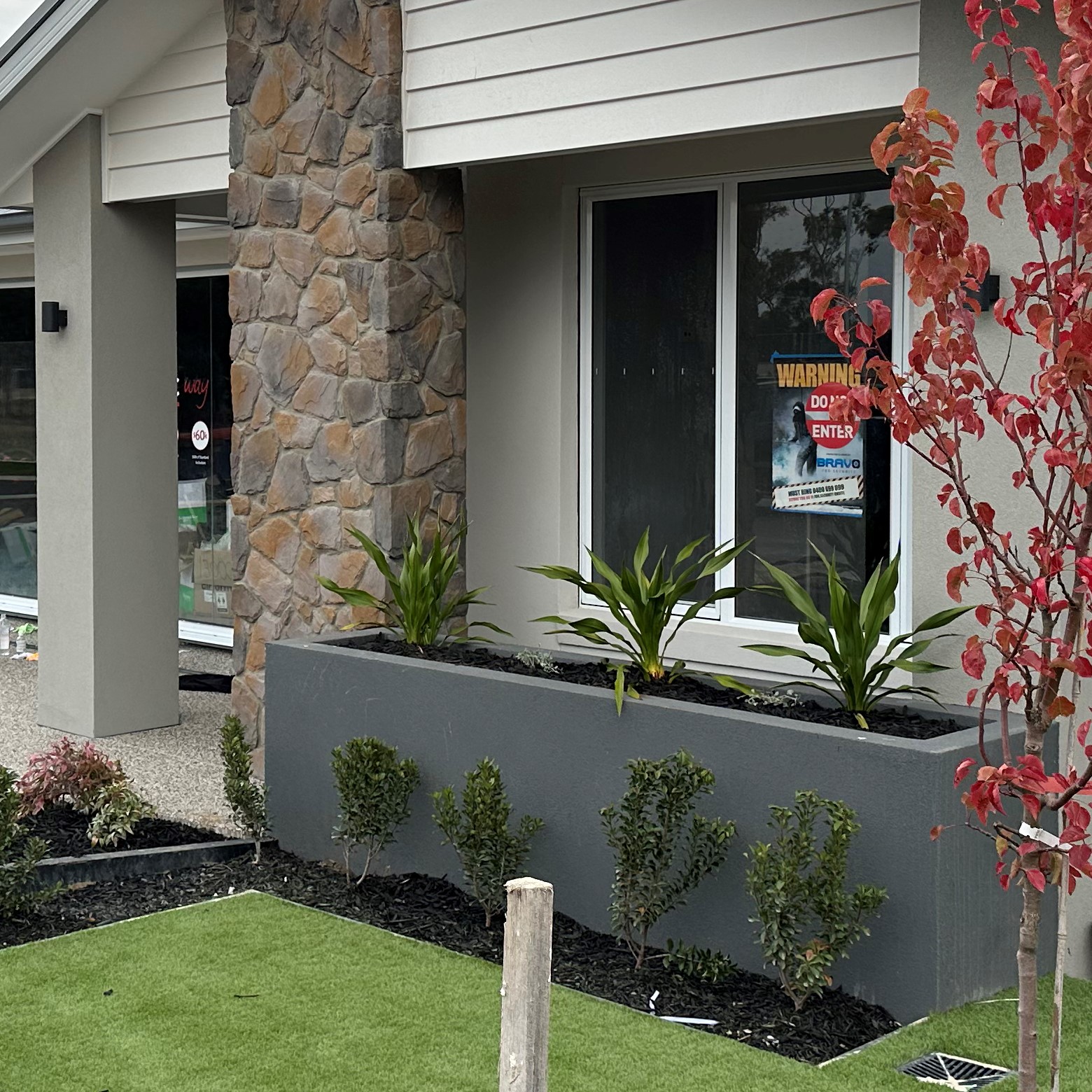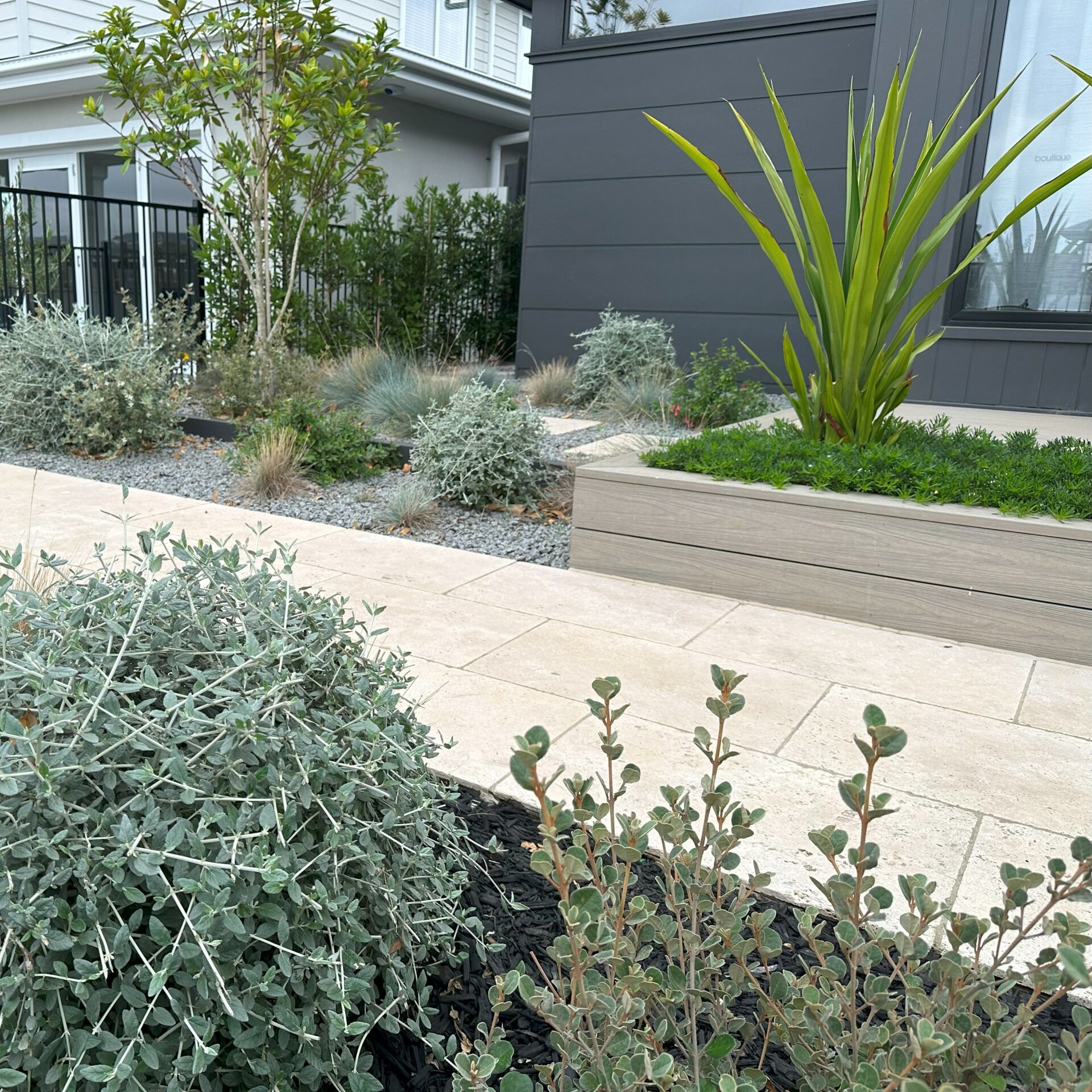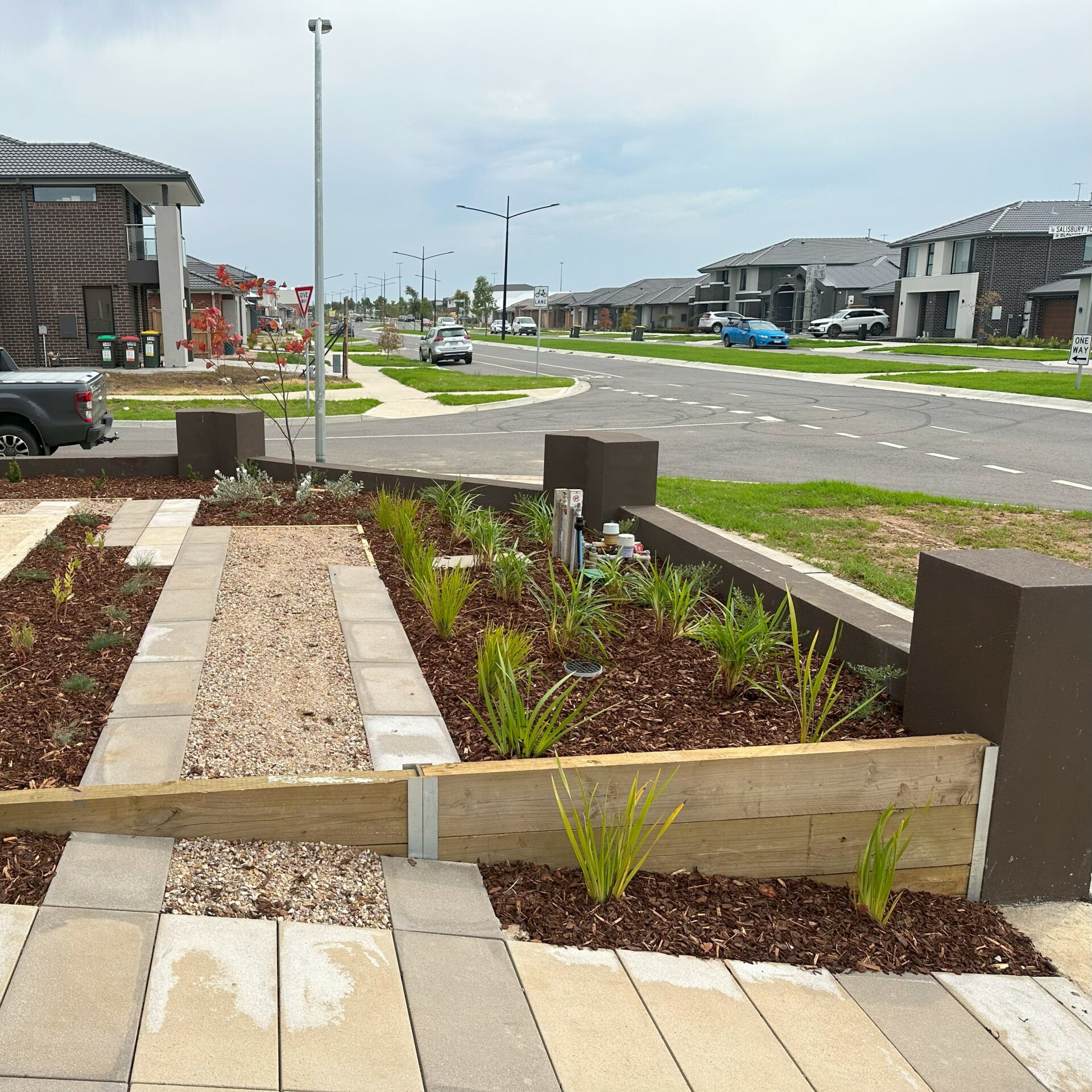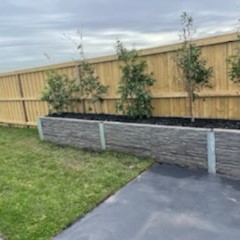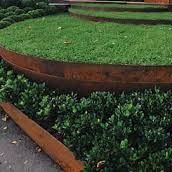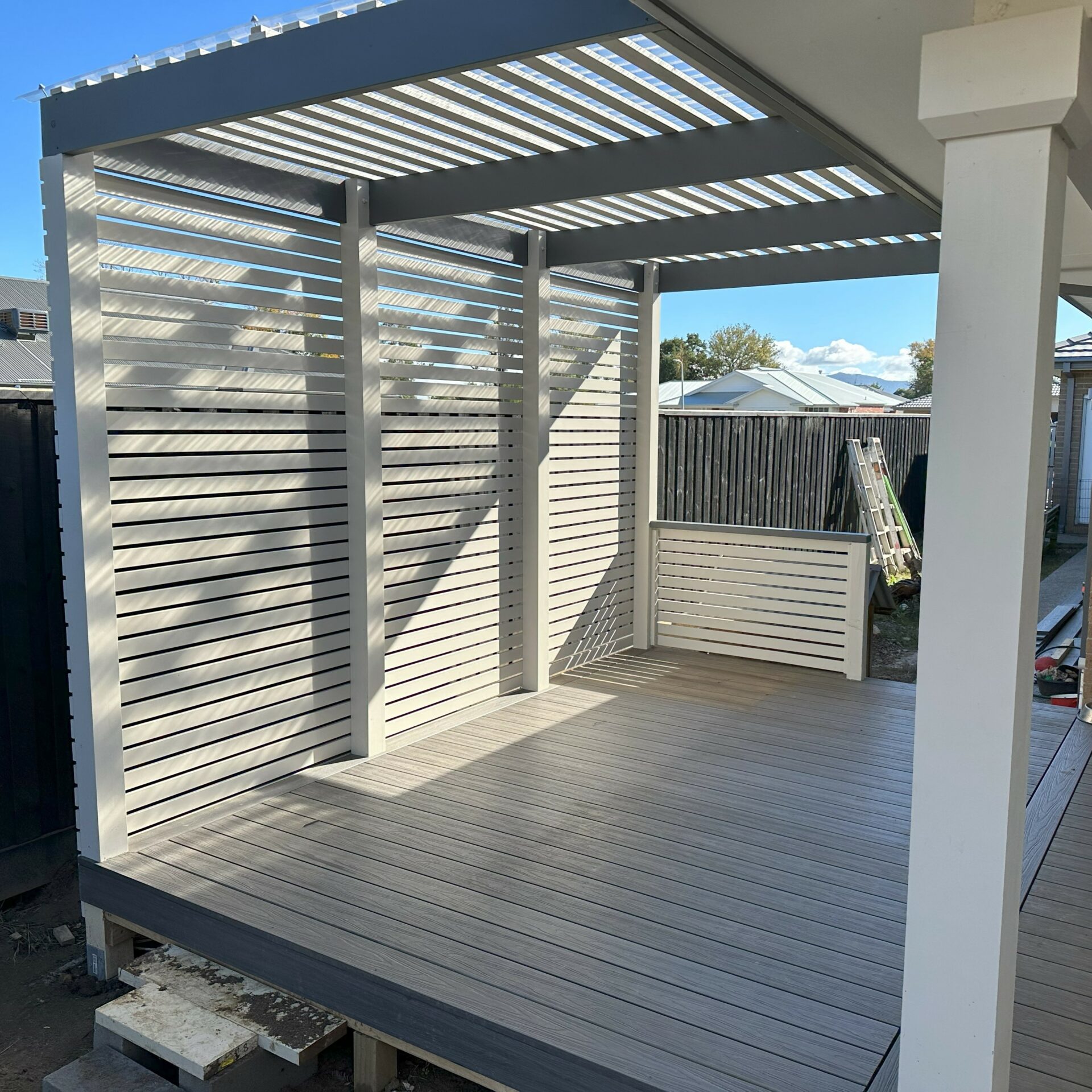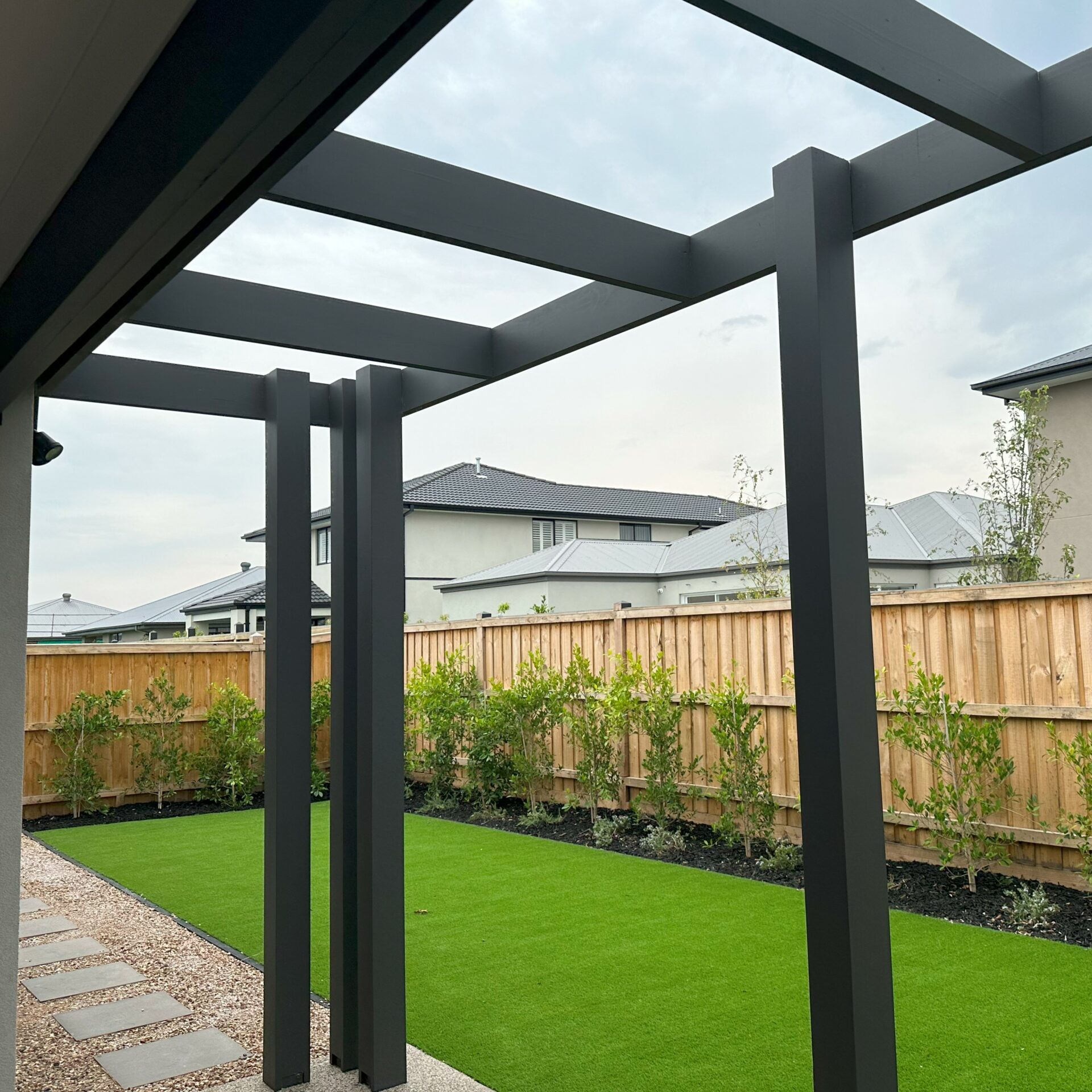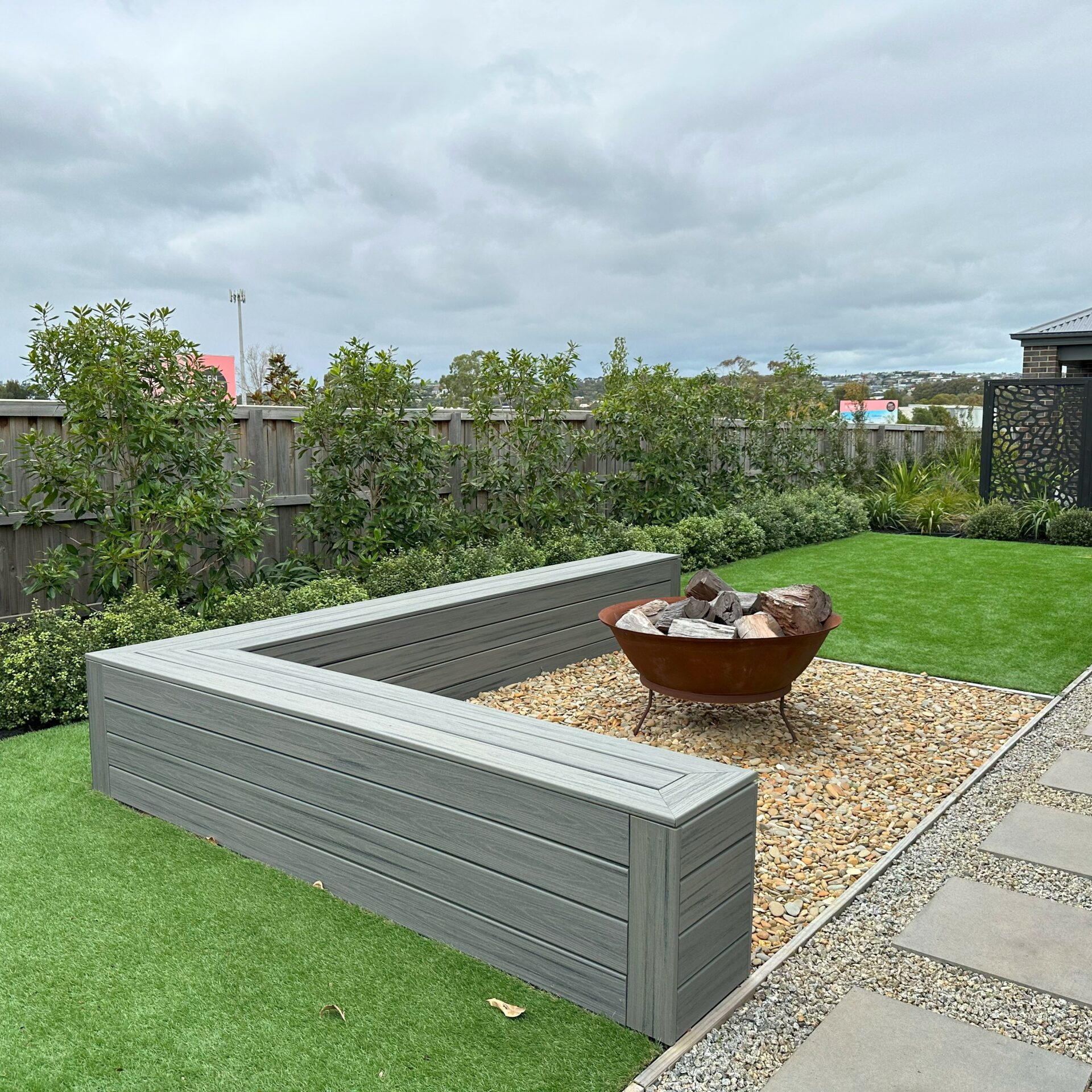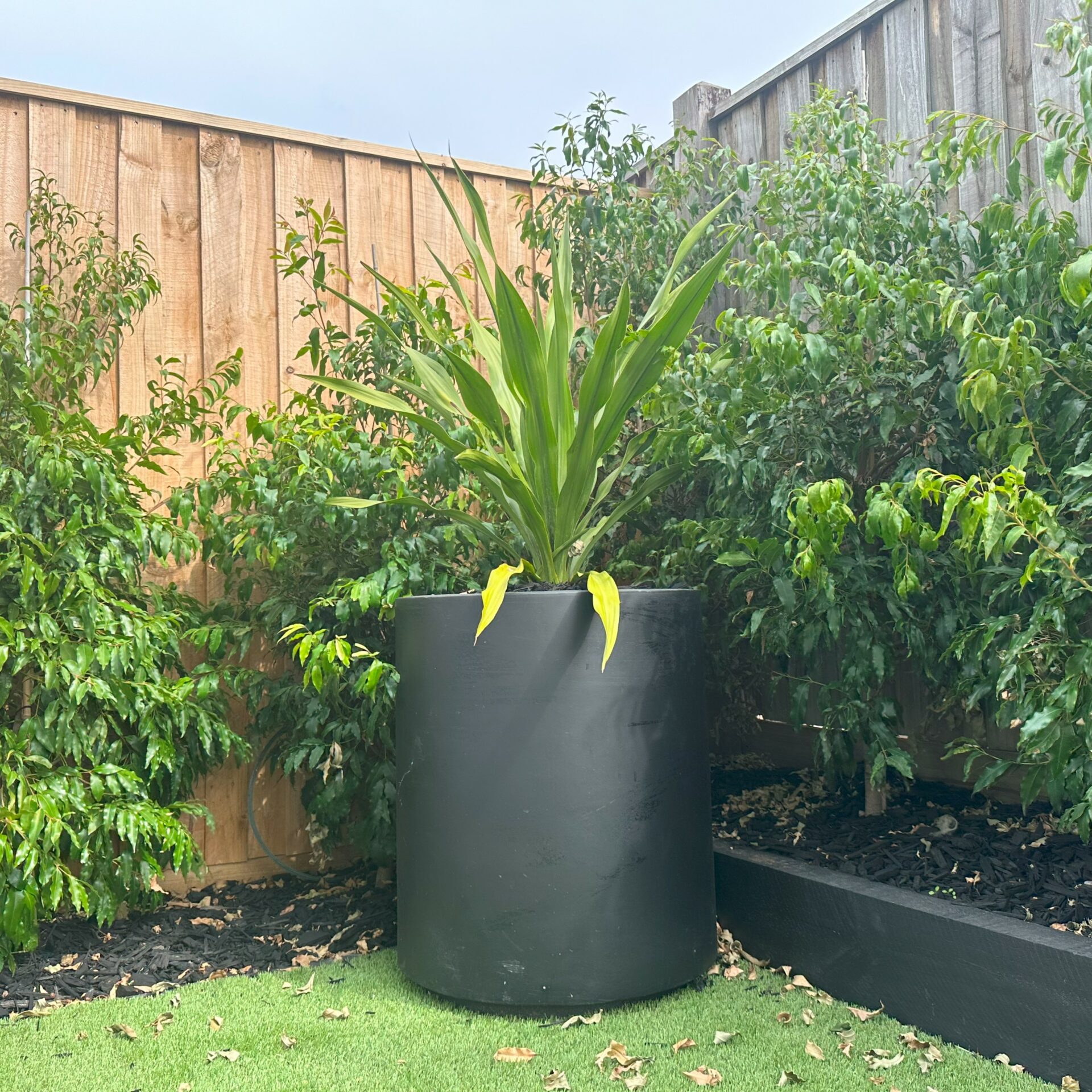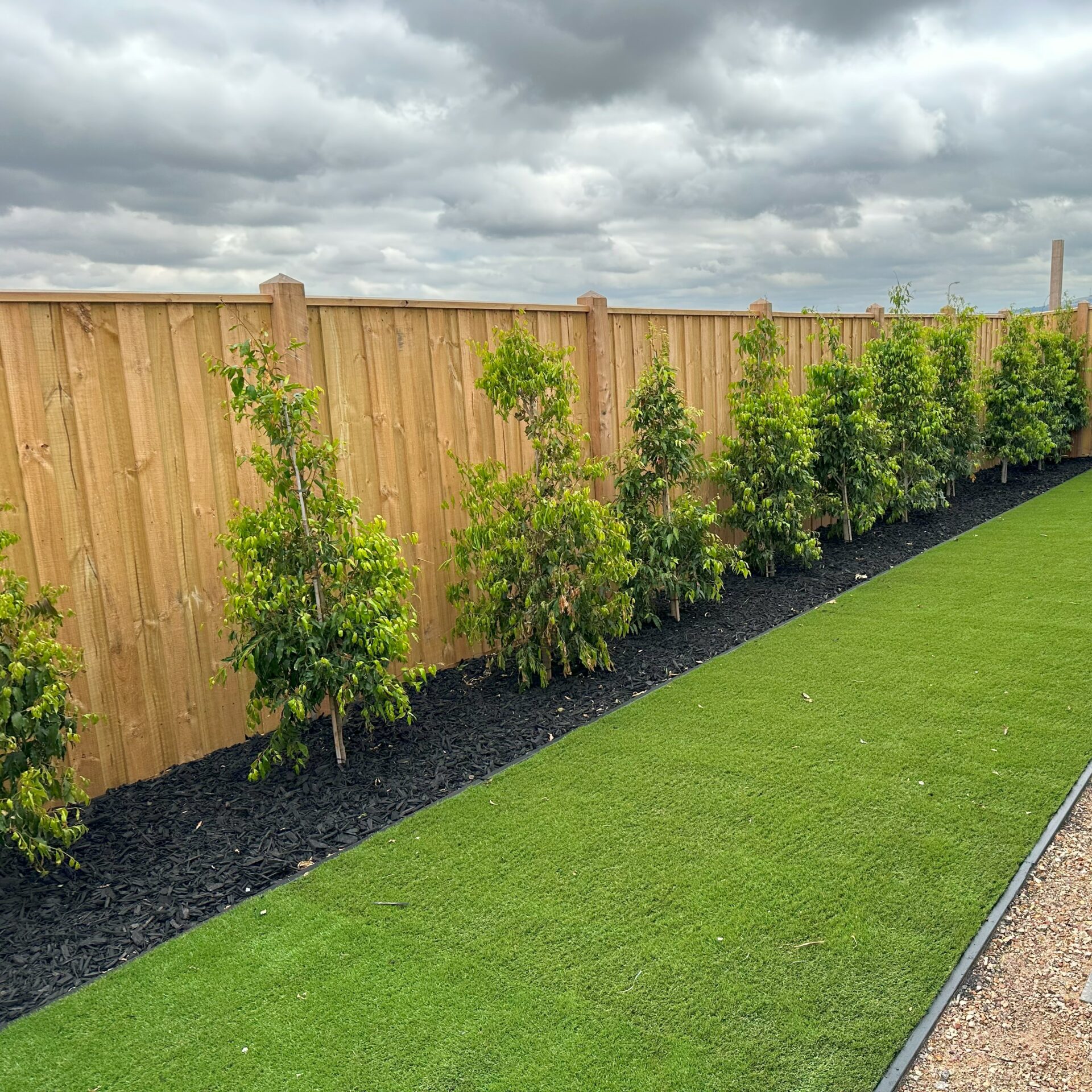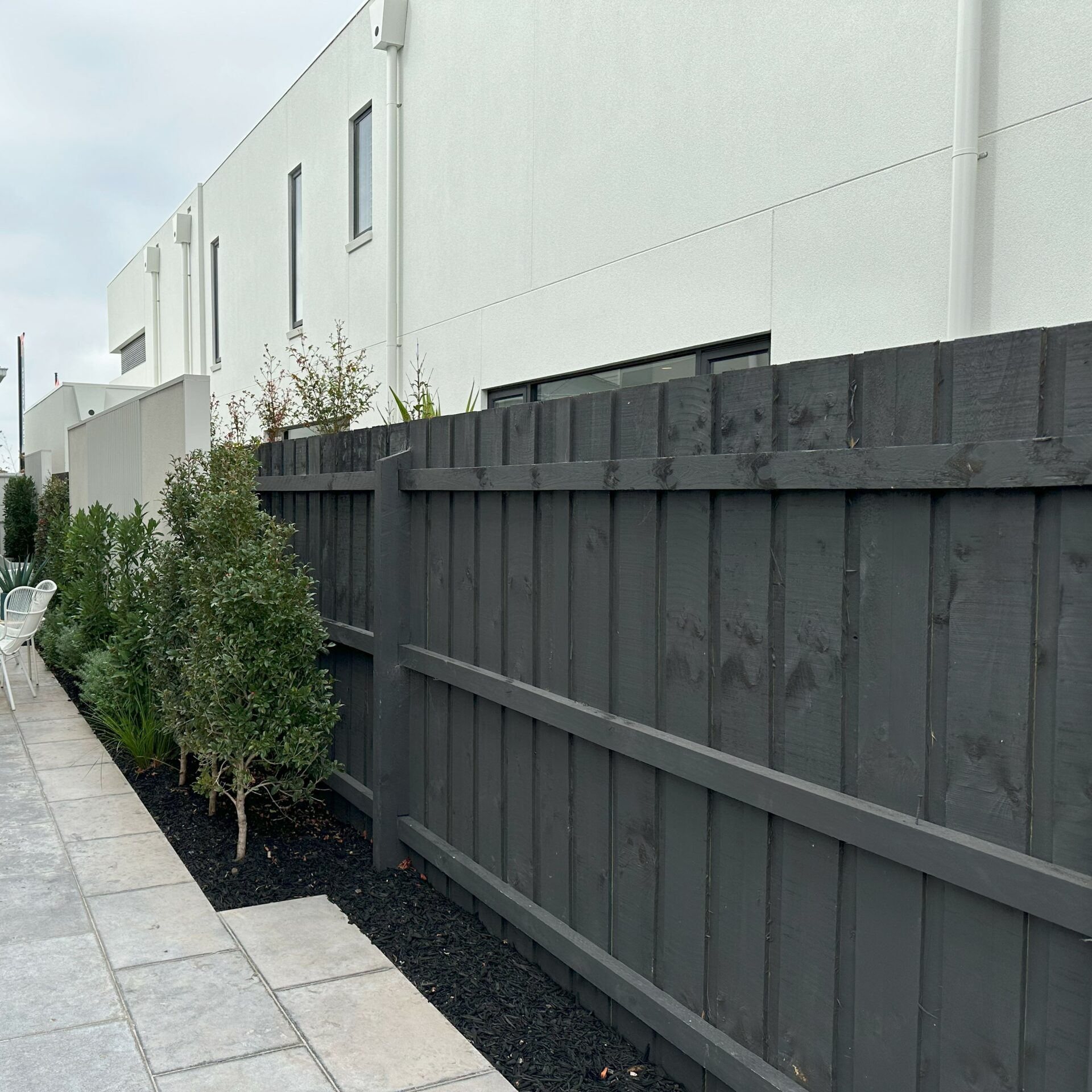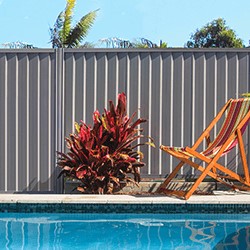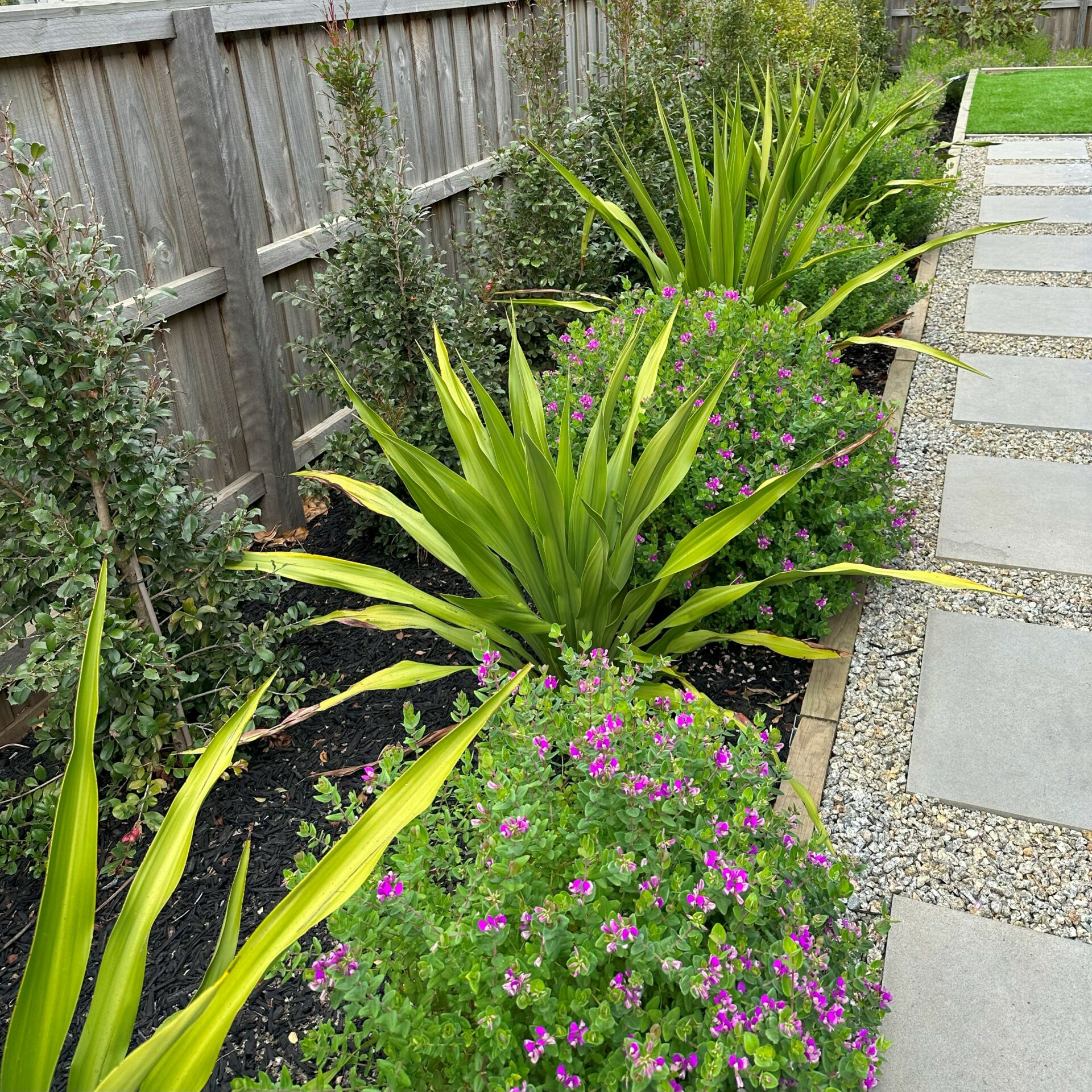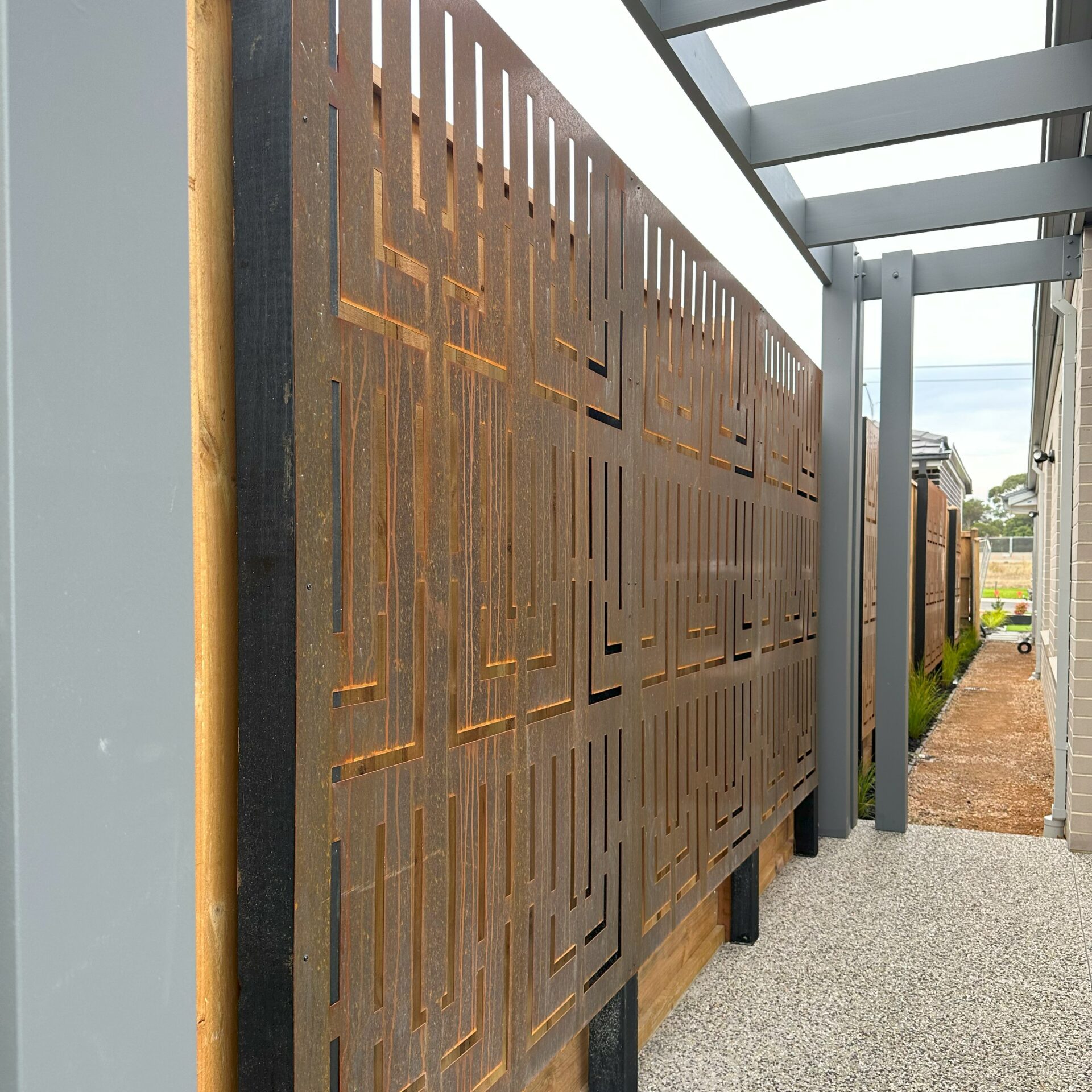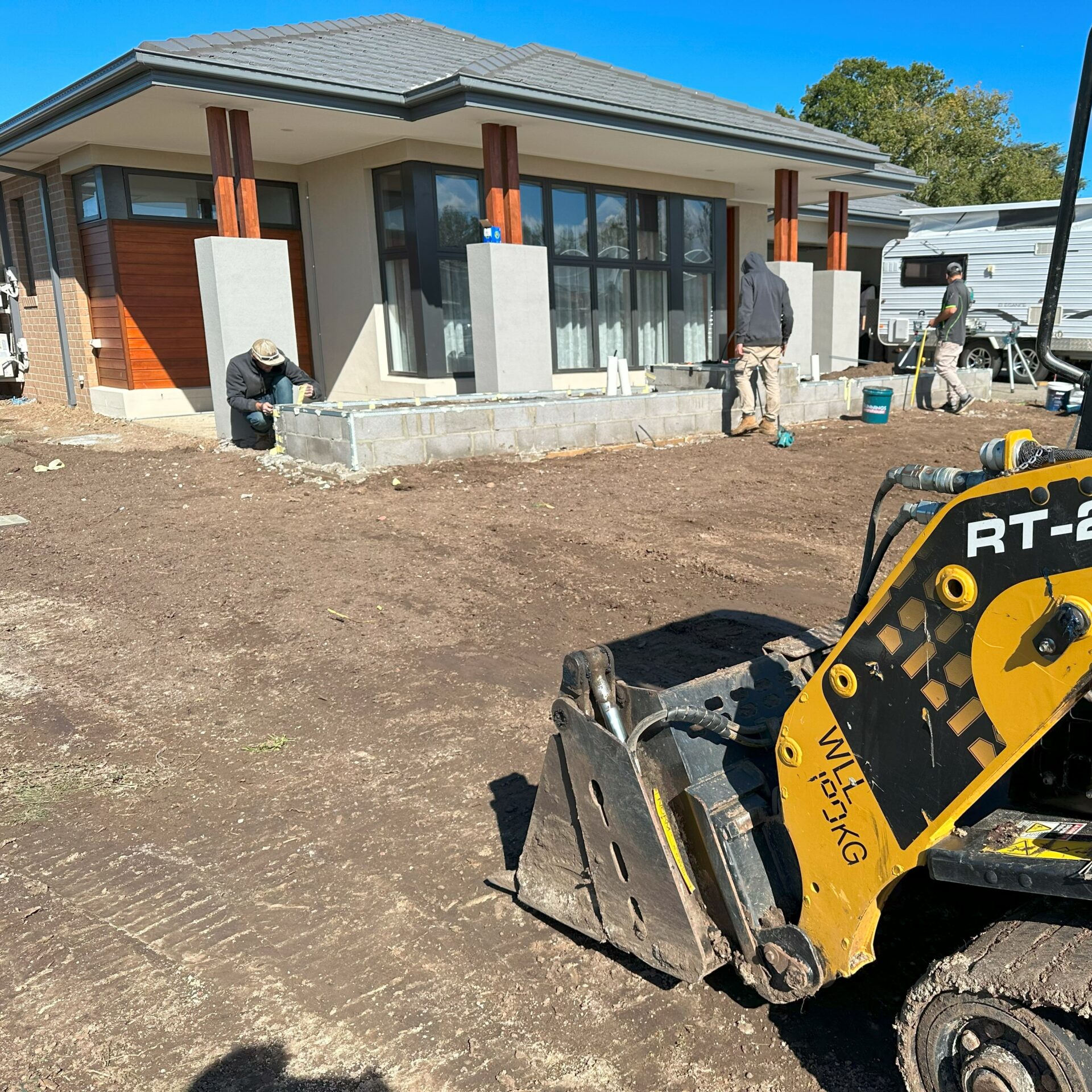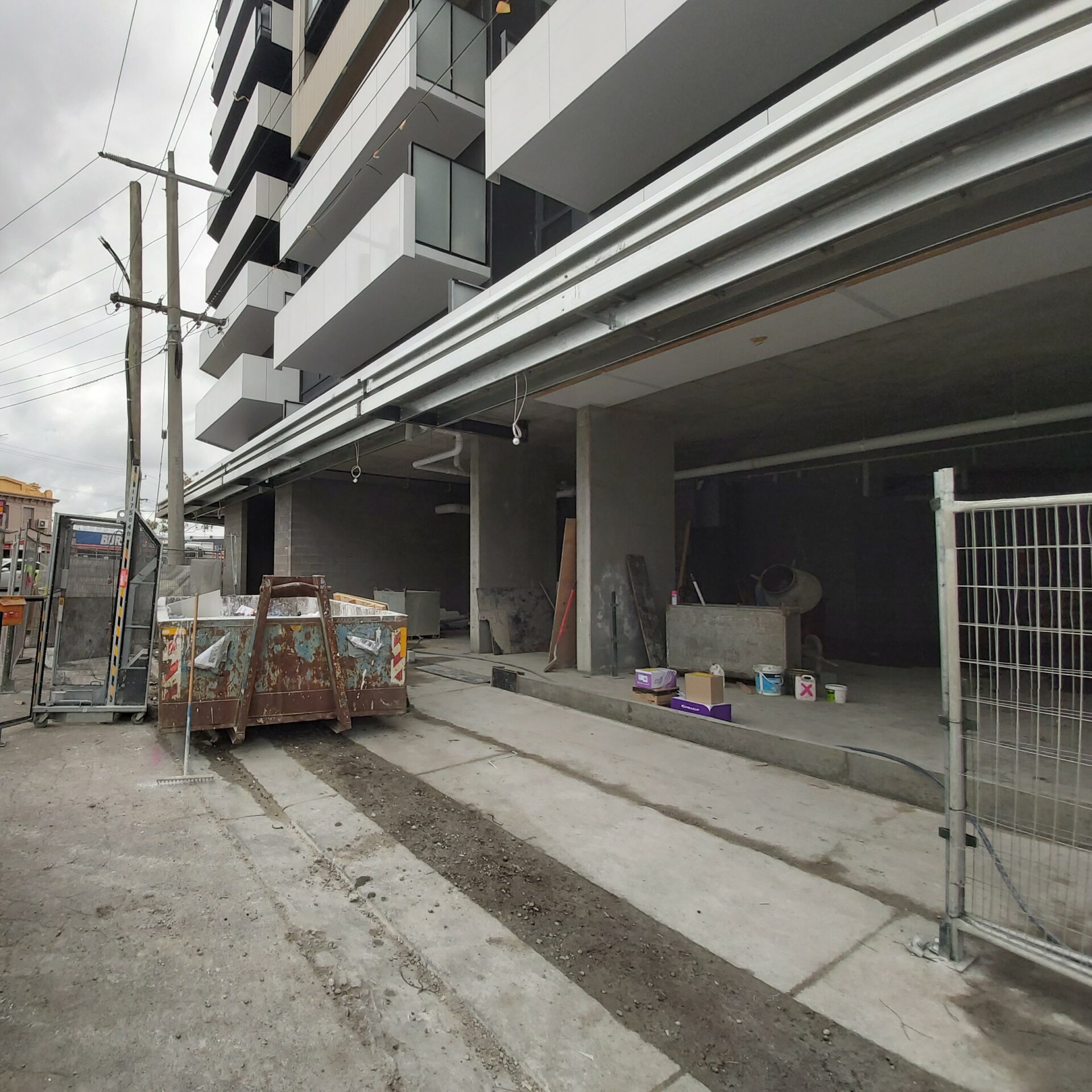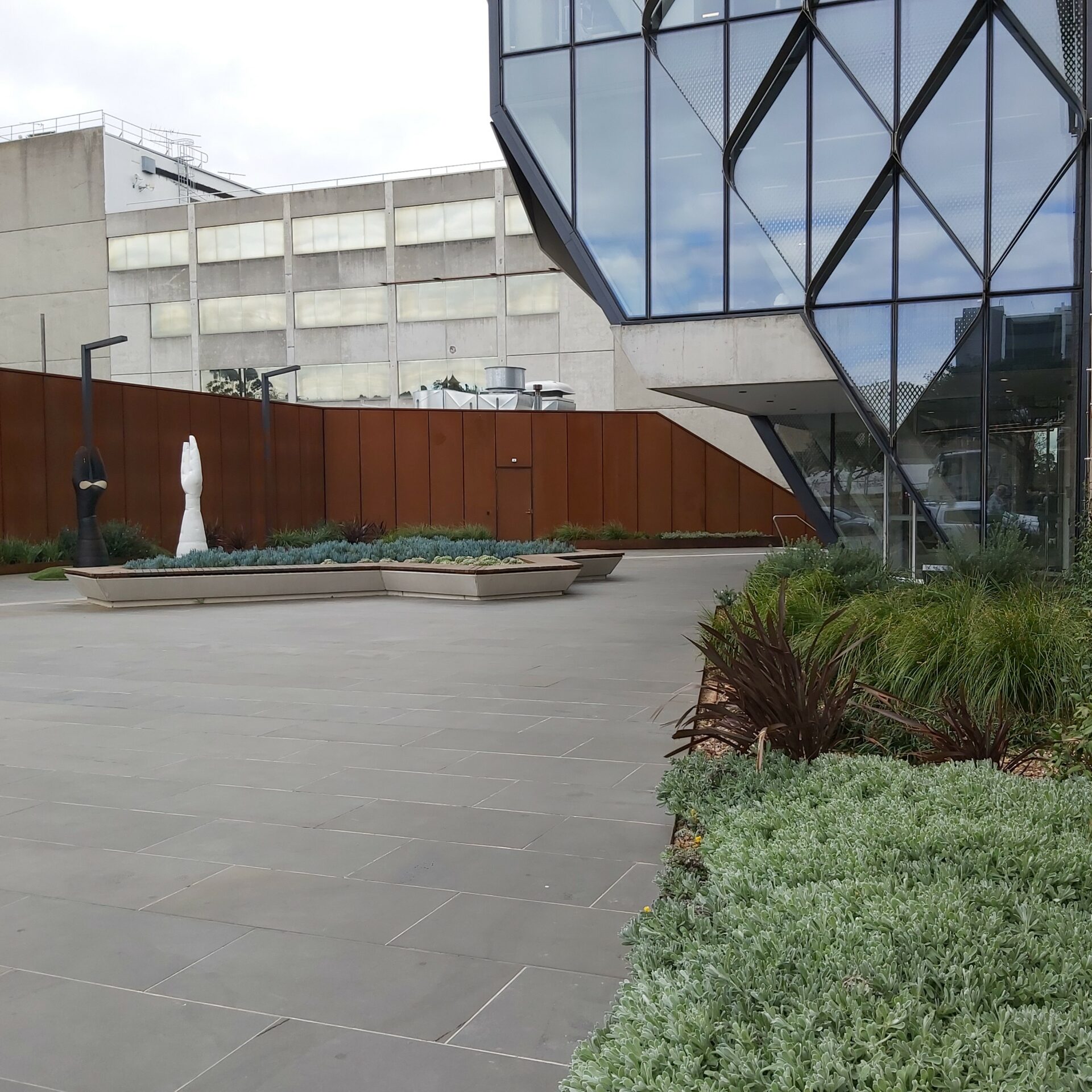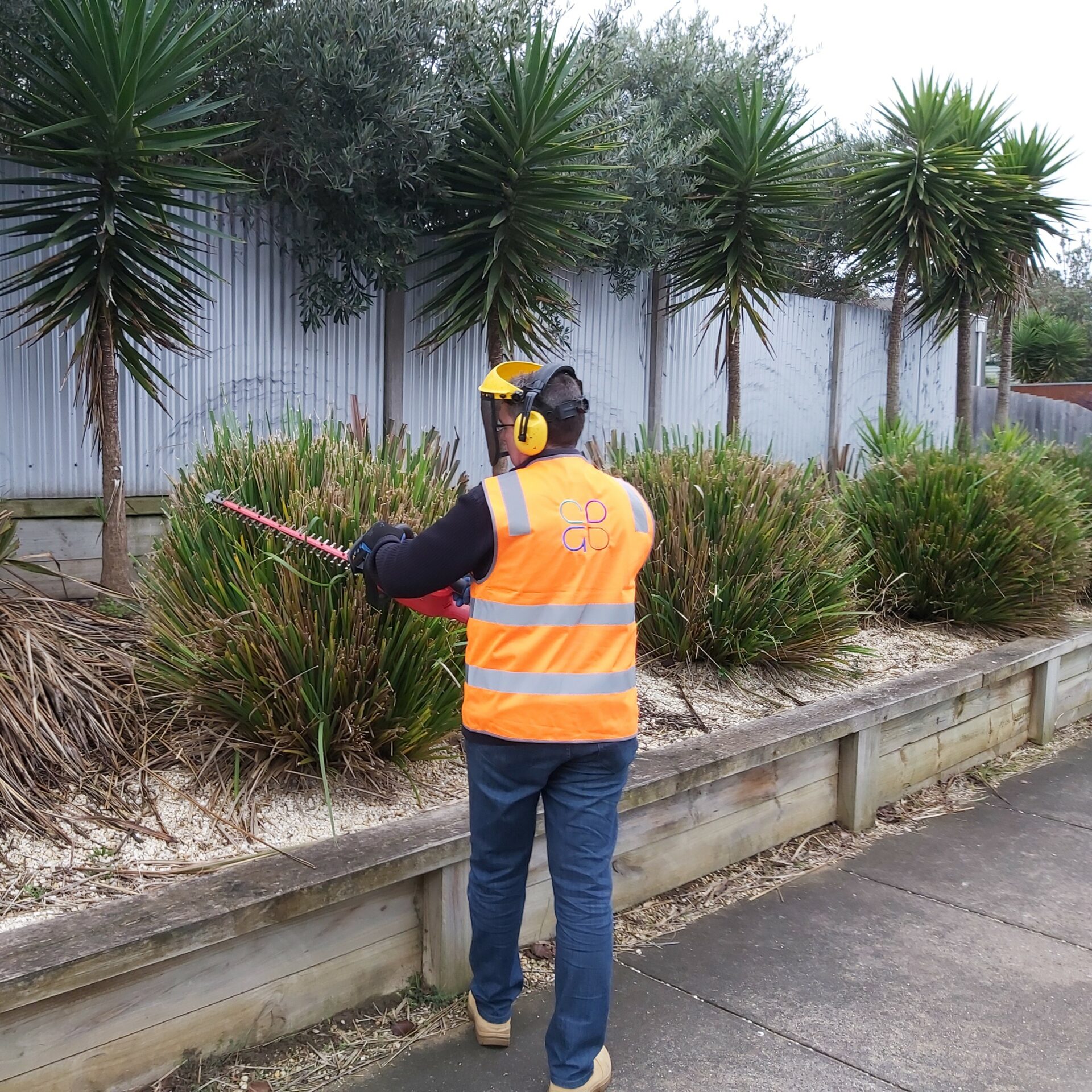Hard landscaping and construction is at the very foundation of overall garden design.
Creating great outdoor spaces to enjoy will often require landscape construction components, which is more than just gardening.
These hardscapes can be costly but can increase the value of your home, creating spectacular areas that make your outdoor space more liveable and add to its visual appeal.
Our services include:
- Paths & Driveways
- Paving & Stepstones
- Decks & Patios
- Garden Beds & Retaining Walls
- Screens, Seating & Features
- Fencing
PATHS & DRIVEWAYS
Pathways can be as simple or as complex as desired, and are essential in defining the way that outdoor spaces are used.
Paths can be a centre piece of a great landscape.
What options do I have for paths?
The main choices are:
- Exposed Aggregate- This concrete has a layer of aggregate (stone/pebble etc) on the surface which is exposed during the curing process to leave behind a more attractive surface finish.
- Standard or Coloured Concrete- Grey is the standard colour, but the option to tint can provide colour variations.
- Compacted Toppings & Crushed Rock Paths
- Pebble Paths
- Step stone paths
- Paved Paths
What should I know about using pavers?
Entry level pavers are typically made of concrete, whilst the more expensive choices are natural stone.
Natural stone provides the best result, however the difference in price can be quite dramatic.
Pavers can be laid on a compacted crushed rock base, however the most durable and lasting method is to lay them onto a concrete base using mortar.
The standard and most cost effective way to lay pavers is in a stack or brick pattern. Rectangular pavers can be laid in other formats, including basket weave, herringbone and french style (ashlar), but these methods are more time consuming to lay and are therefore more expensive overall.
Can pavers be used as step stones?
Pavers are a good choice to be used as a step stone. Consider the size of the paver so that it is laid to match a person’s walking stride, and that the size of the paver is larger that the typical human foot.
When using pebbles, gravel & toppings, do I have choices of colour?
Yes. Many different natural colours exist, and choices are wide.
DECKING & PATIOS
These areas are extensions of the indoors, and are typically the most used part of an outdoor living area.
With good design, decks and patios become the place where people come together.
How do I choose between timber decks & paved patios?
Paved areas are suited to level ground, where as a timber deck can be used effectively (with steps) to deal with sloping land.
Both area great options.
What materials can be used to create decks?
Decks can be made of real timber, with these requiring maintenance over time to ensure that they remain in good condition.
Eco-wood decks provide a maintenance free option at a higher price point.
Decks can often be built over existing steps or concrete paths, so long as a strong foundation can be created.
Sometimes building this way is helpful in reducing the need for demolition and the extra cost that entails.
What options do I have for the style of paving?
The first choice is materials, and like everything, there are both budget and expensive options.
The most economical pavers are typically made from drycast concrete, whilst the more expensive options are from real stone. Prices can vary markedly.
Pavers are best laid on a concrete base using mortar, but can equally be laid on compacted crush rock which is less expensive. Laying pavers on concrete will provide a more durable, long term result.
Laying patterns that are available include brick pattern (aka stretcher bond), stack bond, herringbone, basketweave and ashler (french style). These laying patterns can then also be laid at 45deg angle, which creates a different appearance altogether.
The more complex the laying pattern, the more expensive the laying cost due to additional time.
Is concrete a good option for patios?
Yes – concrete is a popular and durable material for patio construction. Why:
- Durability: Concrete is known for its strength and longevity. It can withstand foot traffic, weather, and other environmental factors over the long run.
- Versatility: Concrete can be poured into various shapes and sizes, allowing for creative design. It can be stamped, stained, or textured to resemble other materials such as brick, stone, or tile, offering a wide range of aesthetic options for your patio.
- Low maintenance: Concrete patios are relatively easy to maintain.
- Cost-effective: Compared to some other patio materials like natural stone, pavers or timber decks, concrete is often more affordable.
- Long-lasting appearance: Concrete patios can maintain their visual appeal for many years. Unlike materials that may fade or discolor over time, concrete patios can retain their original appearance longer.
However, it’s worth noting that concrete can crack, especially in areas with adjacent trees, or in areas with temperature fluctuations or unstable soil conditions. Proper installation techniques, such as incorporating reinforcement and expansion joints, can help minimise this risk.
RAISED GARDEN BEDS & EDGING
Simple enough, but these choices are both practical and important in tying together areas in the landscape.
Raised garden beds are a great way of creating layers in garden design, and in turn showcasing plants.
Why do I need garden edging?
Garden edging is a core element in landscape design, as it provides a clear transition point between differing material choices (for example turf, requiring soil being separated from a path, perhaps using a crushed rock base). Edging creates a basis for the levels across the design.
In many cases other hardscapes (paths, driveways, planter boxes etc) create one edge by default, however there are many parts of the garden that will need separation. This becomes expecially important in garden bed design, as garden beds need to retain mulch or to have a clear edge to mow up to.
What can a raised garden bed add to garden design?
Raised garden beds offer several benefits in landscape design:
- Improved soil quality: Raised garden beds allow you to have better control over the soil quality and composition. You can fill the beds with high-quality soil and compost, which can promote healthy root development, improve drainage, and enhance overall plant growth.
- Enhanced drainage: Raised beds typically have better drainage compared to traditional in-ground gardens. Excess water can drain more effectively from the elevated beds, preventing issues like waterlogging and root rot. This is particularly beneficial in areas with heavy rainfall or poorly draining soil.
- Easier access and maintenance: The raised height of the beds reduces the need for excessive bending or kneeling, making gardening tasks more accessible and comfortable. Raised beds are typically easier to maintain, as they provide clear boundaries for plant care and watering.
- Aesthetics and organization: Raised garden beds can add visual interest and structure to your landscape design. They can be built in various shapes, sizes, and materials, allowing for customisation that complements your overall aesthetic.
Are raised garden bed more expensive?
Raised garden beds are typically more expensive than traditional in-ground gardens, basically due to the additional materials and complexity.
As a “constructed” landscaping item, they will typically require strong foundations, usually compricing a concrete pad or footing and steel reinforcments.
They will also require a fill of soil and mulch, adding more materials to the installation.
Are raised garden beds and retaining walls the same?
A raised garden must “retain” soil, and as such the materials used are often similar.
However, by definition, a retaining wall’s express purpose is to hold back soil and they are used extensively in creating flat levels/terraces in gardens to avoid land slippage.
When the level of the soil it is holding back (say in the case of a very slopey block) becomes high (beyond 400mm as a guide), it is essential that an engineer provides a design guidance as the retaining wall starts to become a safety consideration and additionally if slippage occurs there are potential impacts on buildings from soil movement.
In these case, the construction cost can become high due to the depth of the foundations and the specification of the materials.
SCREENS, SEATING & FEATURES
The use of screens can create garden focal points and zones within gardens, but can also provide cover for storage areas & other functional areas in a garden.
Screens can improve the line of sight through windows or doorways, can be used to hide unsightly fences or equipment or to accentuate the effect of a feature piece.
Screens can create garden focal points and enable zoning of spaces, but can also act to hide storage areas and other practical areas.
Why would I add these features to my garden?
Choices around built in screening, seating and other similar features are mainly aesthetic.
For screening, this can often create privacy, but this can also be achieved with smart plant choice and time to grow.
The main reason that garden features like these are chosen is to create lines of visual interest that draw you into the garden or create views from inside the house through doors and windows that enrich the overall home.
Importantly, optional garden features can be used to curate nicer spaces throughout the garden that encourage you to sit or entertain and use the outdoor space in your daily life.
How might I use these garden features cost effectively?
The best design choices when landscaping on a budget are to get the basics right first. Getting the site level, maintainable and basic planting in place should really superseed “fancy” additions if you are on a budget.
When layering in more costly garden features, it makes sense to step back and think of:
- What will I see from inside the house when I look out?
- Privacy, the ability to see children playing outside, the ability to see others when entertaining- every space is different, but when landscaping on a budget you would ideally like the spending outisde to have impact from the inside too, creating visual harmony inside and out.
- Create focal points
- How often will I go to that space?
- Avoid over committing your budget to areas like the side of the house- these areas are mainly functional and unseen, so using lower cost landscaping elements makes sense if working to a budget.
- Are there any practical considerations?
- Think about privacy, hiding garbage bins or obscuring a garden shed.
- How does each space link in my overall garden? What “zones” are my choices creating?
- Things like paths, seating areas, patios, screens and planting all link together to define how the garden is used and how people will naturally transition within the zones your choices create.
FENCING
Fencing
Fences can be as basic as separating your land from a neighbour, right through to an architectural component that compliments your home.
With a large number of materials and designs available to suit every price point, fencing can become a key feature of your outdoor living space.
What kind of fencing option do I have?
Typically the type of fencing used would differ when creating :
- Boundary fences
- Front/Feature fences
Boundary fences are typically:
- Treated pine timber pailing fences (which could then be painted)
- Steel fencing- colourbond
- Pillar and panel systems
Front fences would typically be more expensive as they are what is seen from the road and homeowners would usually make a choice that adds to the design of the home. Some popular choices are:
- Brick/Concrete Pillars and some sort of infill panel inset between the pillars. These panels could be:
- Smooth, solid panels
- Metal designs, typically powdercoated
- Timber slats- vertcal or horizontal
- Heritage timber fencing (Picket fences or similar)
- PVC fencing panel systems
The choices really are quite varied for feature fencing, with personal taste being a larger factor in the final selection.
Fencing can also be used within a property, with a good example being pool fencing. Pool fencing has many standards to follow, but the main choices are:
- Glass panels
- Welded Panels (Powdercoated)
What fencing materials are more durable?
It’s important to note that the durability of a fence is influenced partly by material choice, but equally proper installation and foundations being used.
Long term choices where the material is higher quality, and decisions that mean there is reduced maintenance (eg the need to re-paint or treat) can help prolong the lifespan of any fencing.
Looking for an experienced landscape company, that is experienced and trusted by the biggest names in the building trade?
Enquire with Abelia today to get further advice from our team
Why choose Abelia?
Request a consultation
We’re experts in landscaping & garden maintenance. No job is too complex, too big, or too small. Call us to discuss your needs.

